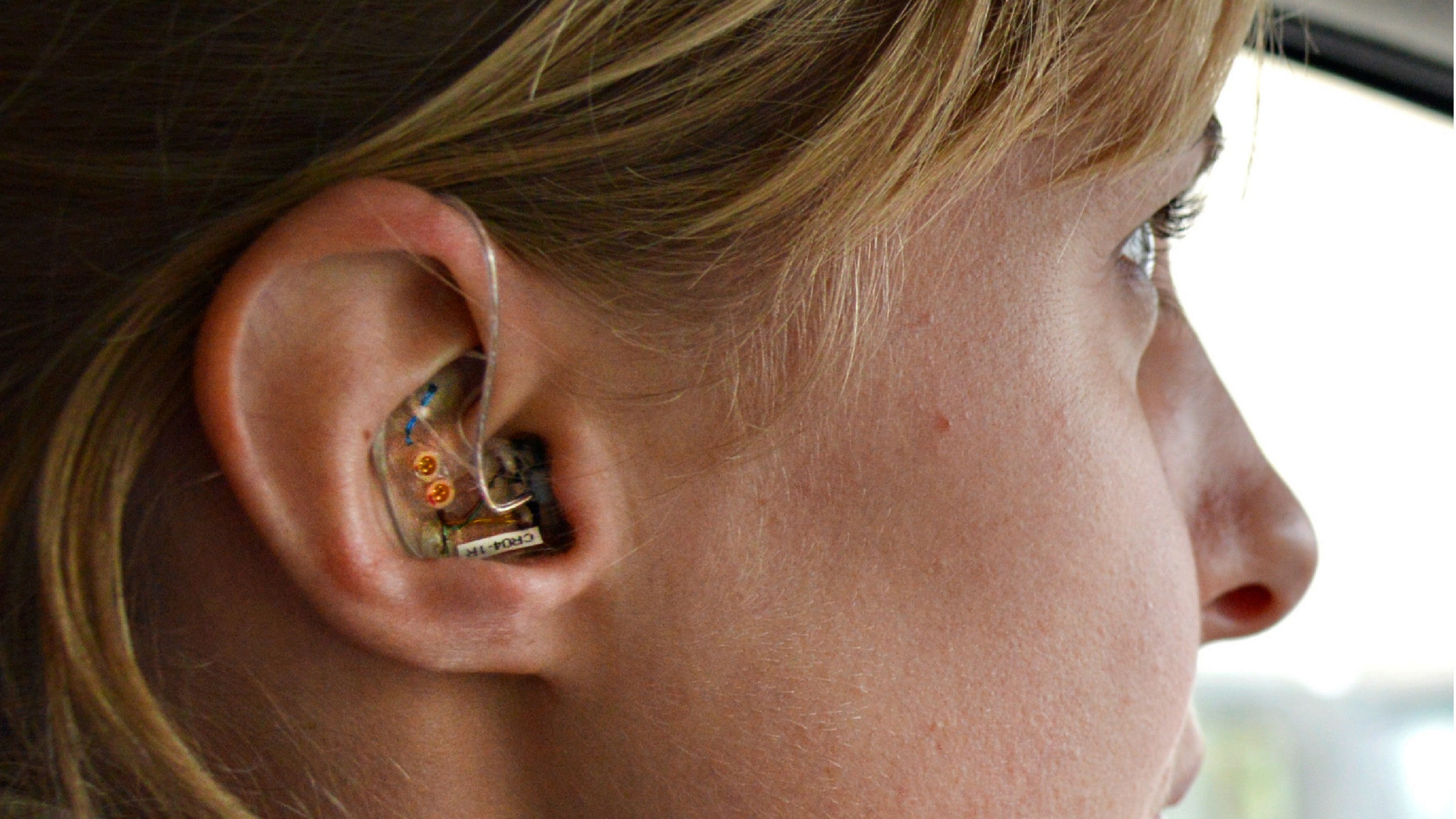When inserted into the ear canal, earbuds are in physical proximity to the brain, enabling the recording of high-quality neural signals known as electroencephalography (EEG) in an unobtrusive form factor, according to University of California, Berkeley (UC Berkeley) associate professor Rikky Muller, co-director of the Berkeley Wireless Research Center and a faculty-fellow recipient of the Bakar Prize for her work on Ear EEG, a method for measuring dynamics of brain activity through the minute voltage changes observable on the skin.
“Ear EEG is enormously promising; in fact, smart earbuds, as a global market, is growing faster than any other wearable, including smart watches,” said Muller. “The inside of the ear canal is uniquely positioned close to the brain, eyes, and facial muscles, allowing the recording of eye and jaw movements in addition to EEG. The combination of these signals will enable the monitoring of drowsiness, sleep, seizures, dementia, and more.”
EEG recording earbuds are being readied for the medical market by Google X start-up NextSense. Said Jonathan Berent, CEO and founder of NextSense, “Our earbuds are closer to the temporal lobe of the brain, an important region for speech and auditory processing. As a result, NextSense hopes to monitor conditions like traumatic brain injuries, sleep disorders, and epileptic seizures as well as anticipate the onset of neurodegenerative conditions like strokes, Alzheimer’s, and Parkinson’s diseases.”
NextSense has been conducting clinical trials using in-ear EEG to diagnose and track sleep disorders and epilepsy since 2019. Berent predicts the results of those trials will be published in peer-reviewed journals in 2024.
At the University of California, San Diego (UC San Diego) Jacobs School of Engineering, Department of Bioengineering professor Gert Cauwenberghs’ lab is publishing in peer-reviewed journals their pioneering work in sensing of the many signals available in the ear canal. In addition to EEG data from the brain, Cauwenberghs’ lab is exploring the tracking of muscle activity (using electromyography, or EMG), skin conductivity (using electrodermal activity, or EDA), eye movements (using electrooculography, or EOG), as well as heart pulse rate, blood-oxygen saturation, and a plethora of chemical biomarkers secreted by sweat for potential inclusion in future medical earbuds.
“Our vision is to create a diagnostic standard for all the brain/body states that can be sensed in the ear canal, turning earbuds into a powerful brain/body sensing device,” said Cauwenberghs.
Cauwenberghs’ research group at UC San Diego recently demonstrated its claim to the world’s first proof-of-concept earbud prototype showing how the ear canal can monitor both electrical and chemical biomarkers. Current prototype earbuds simultaneously monitor electrical activity (EEG, EMG, EDA, and EOG), as well as chemical biomarker levels (specifically lactate levels in sweat). During vigorous exercise (on a stationary bicycle), monitoring instrumentation detected and recorded a direct correlation between elevated lactate levels in sweat and the modulation of electrical activity. In that way, the researchers proved the concept that in-ear monitoring of metabolic and electrical biomarkers can be liberated from the bulky equipment and blood tests performed by medical labs today. Simultaneous electrical and chemical sensors, claims Cauwenberghs, can be correlated by smart earbuds during continuous health monitoring, diagnosis, and eventually even therapy.
Earbuds already are widely used with smartphones, and the Cauwenberghs lab’s prototype took advantage of this by adding their electrical and biochemical sensors to an off-the-shelf set of earbuds. The first step was to pinpoint the ideal locations for each of the sensor’s electrodes on the outside of the commercial earbud. Once this layout was complete and a stencil cut, the team used a layer-by-layer screen printer to deposit the active layers on a flexible 150-micron thick terephthalate polyurethane (TPU) substrate.
The conductive traces, laid down in a serpentine pattern for flexibility, used silver (Ag) ink, then the traces were covered with an insulating layer (except at the ends where the sensing electrodes received an enhanced Ag layer). The biochemical traces were laid down and enhanced with a hydrogel layer that facilitated sweat collection. For chemical sensing, a catalyst-enhanced electrochemical chronoamperometry (CA) technique generates a sensing current proportional to lactate concentration in the sweat.
For the prototype, the flexible substrate—layered atop with the electrical and biochemical sensors—was attached to the outside of off-the-shelf earbuds so their electrodes touched the ear canal in their predetermined ideal positions. For production, the electronics to detect EEG voltages and CA current would be built inside the earbuds, but for the prototype the electronics were externally mounted. The group had demonstrated in earlier work that the necessary electronics will fit inside an earbud using a custom 65-nanometer CMOS chip that consumes just .8 microwatts.
The UC San Diego team aims to close the feedback loop from diagnostic signals output from the brain by responding to them with therapeutic sounds input to the brain. “Our next step is to clinically validate across a large population pool, an abundance of wearable diagnostic and therapeutic applications based on our earbuds,” said Cauwenberghs.
UC San Diego’s diagnostic goals are to monitor interactions between the earbud readouts of brainwaves, vital signs, and chemical biomarkers in real-world settings by correlating electrical brainwave patterns with the body’s chemical biomarkers.
The therapeutic goal, according to Yuchen Xu, a former post-doctorate researcher on the project at UC San Diego and now a research scientist at Aizip is to foster improved brain function by enhancing neuroplasticity (the formation of new synapses) and angiogenesis (the formation of new blood vessels). By using the feedback loop of monitoring the brain/body followed by appropriate stimulation with smart earbuds, the hope is to achieve the ultimate goal of diagnosing the brain/body’s state, learn therapeutic responses, then provide that feedback through the earbuds to improve brain/body conditions.
“The plan is to measure the persons’ brain/body condition, then learn what feedback drives them towards feeling better,” said Xu.
Medical conditions such as tinnitus, for instance, could be treated by smartly closing the feedback loop with appropriate earbud sounds. Even cardiovascular diseases could possibly be mitigated with earbud feedback therapy, according to Cauwenberghs. Likewise, sleep disorders could take advantage of closing the feedback loop with sounds that stimulate the appropriate brain waves.
“Deeper sleep is one of the underrated causes of poor health as people age, and there is no better way to improve it than to play sounds that drive the brain towards deeper sleep,” said Cauwenberghs. “It is also possible to drive the brain toward more pleasant feelings while awake.”
Autonomous sensory meridian response (ASMR), for instance, is a popular relaxation technique that plays audible “triggers” to reduce stress and induce good feelings. ASMR today is open-loop, forcing those seeking relief to use trial and error with the over 25 million ASMR soundtracks online. But by using smart earbuds to close the feedback loop, an algorithm could learn to play just the right triggers for each specific individual, according to Cauwenberghs.
R. Colin Johnson is a Kyoto Prize Fellow who has worked as a technology journalist for two decades.




Join the Discussion (0)
Become a Member or Sign In to Post a Comment